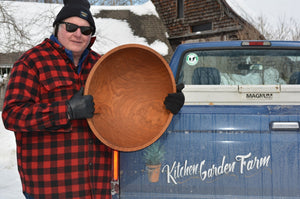- Continue Shopping
- Your Cart is Empty
Why We Use Maple Wood
When we think of Maple, we think of woodenware. The extremely hard, tough surface of Maple will take on a higher polish as it is subjected to wear and use. This is one reason why it is a remarkable material for woodworkers.
Naturally light in color, Maple is the choice for light finishes. The grade known as White Maple, when finished with shellac alone or with beeswax, makes a truly beautiful finish which cannot be duplicated by any other wood. Sometimes Maple is bleached before finishing making it even whiter. And Maple, of course, is much used for furniture, especially the curly and the bird's-eye Maples. For floors which are subject to much traffic, maple has no equal. You'll find Maple in school gym floors, dance floors, kitchens, bedrooms, halls, hand turned wood bowls and wooden kitchen boards.
Maple is a close-grain, very hard, fine-textured, tough and strong wood. The sapwood is very light in color, while the heartwood is a light brown. The grain figure is subdued but beautiful and quite uniform and interesting as well.
All Maple is light in color, but the white, clear grade is especially light. It is the sapwood from the outside of the log, winter-sawed and end piled in sheds to prevent staining. It is ivory white and the finest grade of maple flooring and lumber produced. Birch floors and trim give an airy, cheerful color to a room which reminds one of the northern forests where the best maple trees grow.
Maple is common to England, Central Europe and North America. Curly Maple is the wood which results from trees which have made a twisted growth and which peculiarity has been preserved by special methods of cutting the lumber. It has a curly, mottled figure quite similar to satinwood. Bird's-eye Maple is actually Sugar Maple. The peculiar bird's-eye knots are presumed to be the result of buds or shoots which formed in the wood but were unable to penetrate the hard, tough bark and thus come out to form branches. Sugar Maple when newly cut is a creamy white in color, but it darkens to a golden yellow with age. In finishing this bird's-eye maple the best practice is 'to put on a toner in the form of a water solution of tannic acid. This brings out the little eyes or knots interestingly. The toner is followed with a weak water stain.
Traditional wooden bowl producers in Vermont frequently worked in Maple. They were the Weston Bowl Mill, The Bowl Mill also known as the Granville Bowl Company and Woodbury Bowl.
Today at New Hampshire Bowl and Board we choose Maple for wood bowls, especially our chop bowls and for salad servers. Maple is also a preferred wood for many of our wooden spoons and kitchen utensils. The straight grain, hardness and density of the wood make for a very fine product that will stand up to the wear and tear of a busy home cook.
Big Cherry Wooden Salad Bowl Ship Free 17" (Serves 20)
from $ 399.99
Bowls like this one were the specialty of the Weston Bowl Mill.






